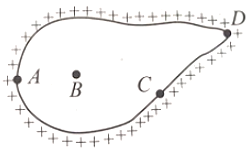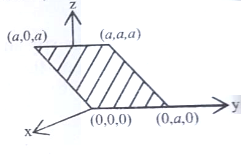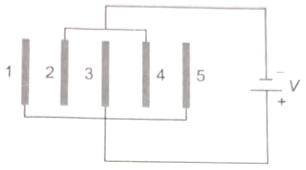A ring of charge with radius 0.5 m has 0.002 m gap. If the ring carries a charge +1 C, the electric field at the centre is:
1.
2.
3.
4.
For an isolated charged conductor shown in Fig. the potential at points A, B, c and D are V, V, V, and V, respectively. Then
Three capacitors \(A\), \(B\) and \(C\) are connected in a circuit as shown in Fig. What is the charge in \(\mu \text{C}\) on the capacitor \(B\):

| 1. | \(\frac{1}{3}\) | 2. | \(\frac{2}{3}\) |
| 3. | \(1\) | 4. | \(\frac{4}{3}\) |
A particle of mass \(m\) and charge \(\text-q\) moves diametrically through a uniformly charged sphere of radius \(R\) with total charge \(Q\). The angular frequency of the particle's simple harmonic motion, if its amplitude \(<R\), is given by:
1. \(\sqrt{\dfrac{qQ}{4 \pi \varepsilon_0 ~mR} }\)
2. \(\sqrt{\dfrac{qQ}{4 \pi \varepsilon_0 ~mR^2} }\)
3. \(\sqrt{\dfrac{qQ}{4 \pi \varepsilon_0 ~mR^3}}\)
4. \( \sqrt{\dfrac{m}{4 \pi \varepsilon_0 ~qQ} }\)
In the circuit shown in Fig. C = 6 F. The charge stored in the capacitor of capacity C is
1. zero
2. 90 C
3. 40 C
4. 60 C
In Fig., if the potential at point B is taken as zero, then the potential at point A will be
1. 8 V
2. 16 V
3. 24 V
4. none of the above
A charge +q is fixed at each of the points upto on X-axis and charge -q is fixed on each of the points upto . Here is a positive constant. Take the potential at a point due to a charge Q at a distance r from it to be . Then the potential at the origin due to above system of charges will be
Three concentric charged metallic spherical shells A, B and C have radii a, b and c; charge densities and and potential and respectively. Then which of the following relations is correct?
Two parallel-plate capacitors of capacitances C and 2C are connected in parallel and charged to potential differences V. The battery is then disconnected and the region between the plates of C is filled completely with a material of dielectric constant K. The common potential difference across the combination becomes
The electric potential at a point (x, y, z) is given by V = . The electric field at that point is
Two point dipoles of dipole moment \(\vec{p}_{1}\) and \(\vec{p}_{2}\) are at a distance \(x\) from each other and \(\vec{p}_{1} \left|\right| \vec{p}_{2}\). The force between the dipole is:
1. \(\frac{1}{4 π\varepsilon_{0}} \frac{4 p_{1} p_{2}}{x^{4}}\)
2. \(\frac{1}{4 π\varepsilon_{0}} \frac{3 p_{1} p_{2}}{x^{3}}\)
3. \(\frac{1}{4π\varepsilon_{0}} \frac{6 p_{1} p_{2}}{x^{4}}\)
4. \(\frac{1}{4 π\varepsilon_{0}} \frac{8 p_{1} p_{2}}{x^{4}}\)
Consider an electric field where is a constant. The flux through the shaded area(as shown in the figure) due to this field is 
1.
2.
3.
4.
Five identical plates each of area A are joined as shown in the figure. The distance between the plates is d. The plates are connected to a potential difference of V volt. The charge on plates 1 and 4 will be
1.
2.
3.
4.
A thin semi-circular ring of radius r has a positive charge q distributed uniformly over it. The net field E at the centre O is 
1.
2.
3.
4.
Some equipotential surface are shown in fig. The magnitude and direction of the electric field is
1. 100 making angle 120 with the x-axis
2. 200 making angle 60 with the x-axis
3. 200 making angle 120 with the x-axis
4. None of the above
| 1. | \(V = -x+y+\) constant |
| 2. | \(V\) = constant |
| 3. | \(V=-\left({x}^2+{y}^2\right)+\) constant |
| 4. | \(V=-x y+\) constant |